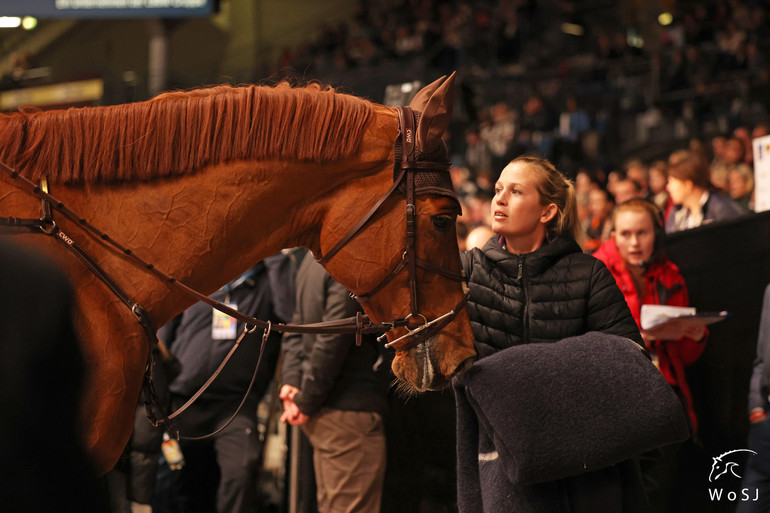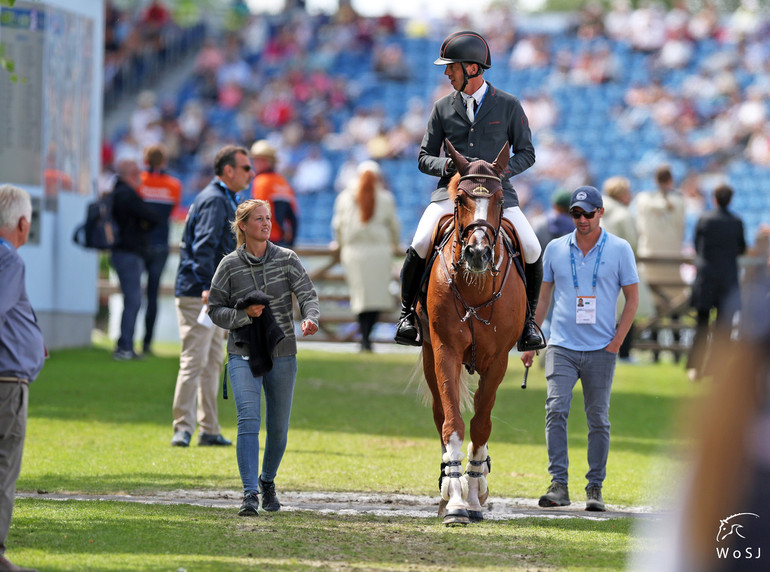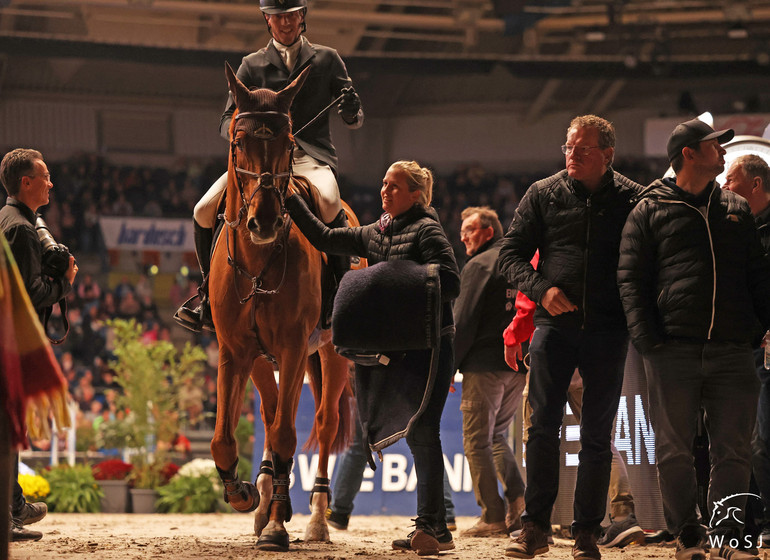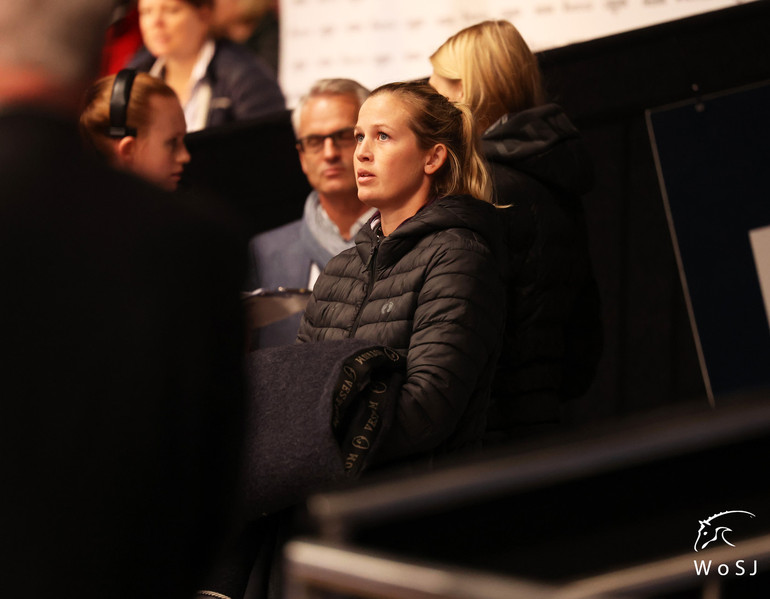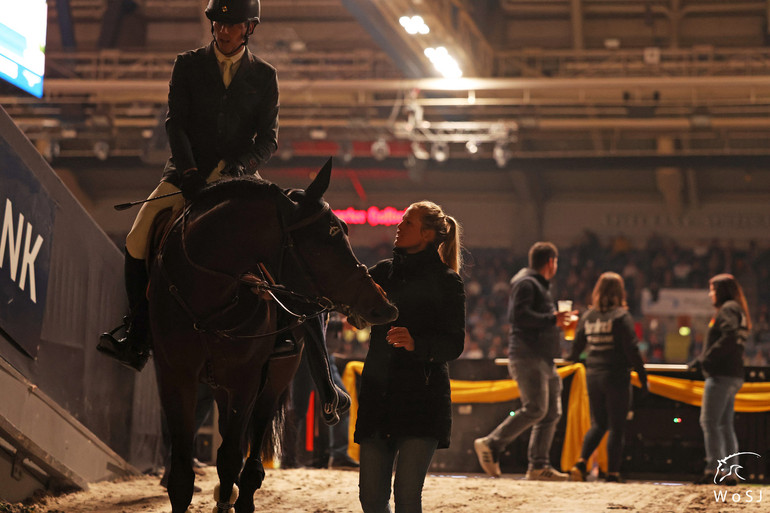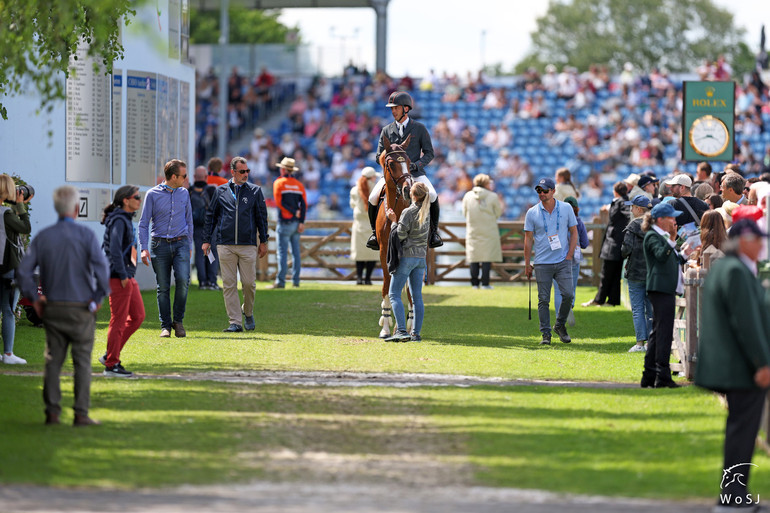Text © World of Showjumping
For over a decade, Josefin Göransson has been working with Harrie Smolders – Dutch Olympian and former world number one. To begin with, Göransson worked with Smolders’ student Audrey Coulter – after Coulter stopped riding, she took on a full-time position for Smolders. To World of Showjumping, the 32-year-old Swede talks about the lessons she has learned during her many years in the industry. “As a groom, the most challenging part is to take time for yourself and let go of the work – I get so into to my job, and I know it is an issue many others struggle with too.”
Born with it
Göransson believes that she was born with a love for horses. “My parents tell me about how, when I was just learning to walk, I would go out on my own to our neighbour’s horses and feed them. My parents had to come after me all the time,” she laughs. “I think the love for horses was there from the beginning. Already when I was in high school, I decided that I wanted to make a living by working with horses; somehow I always had a burning interest for them. In Sweden we have a few equine focused schools where you can get a degree in grooming. I studied really hard to get in, and moved away from home to study when I was 16.”
As a groom, the most challenging part is to take time for yourself and let go of the work
Through her school, Göransson got an internship at Jens Fredricson’s yard. “He was a great teacher, really inspiring,” Göransson tells. “After Jens I went to Denmark, which was an interesting experience at a really big yard with over 500 horses – both dressage and jumpers. I got to ride a lot, learned so much and met many people from different cultures.”
It has been a long journey to end up working with Smolders. Before finding her way to Harrie’s stable, Göransson experienced many different working environments. “I was also in Germany, where I did 27 stables on my own in the mornings and then rode 12 horses every day – I don’t know how it was even physically possible. Then I went to Ireland, where I learned a lot about getting the young horses used to the saddle, saw a whole new system of managing horses and how they train – it was really interesting. That was the start of me figuring out what I really wanted to do, and what type of working conditions I wanted to have. I believe you go through all these places where you learn a lot, but at some point, you have to start standing up for yourself. After Ireland, I worked in Norway and that was the first job where I had good working conditions – it was a higher standard. This was when I realized what kind of people I wanted to work for. It was also the first time I started to go to shows as a groom.”
Months turned into years
Finally, Göransson ended up working with Audrey Coulter. “A friend of mine asked me to help out for a few months, so I thought I could do that – but ended up never leaving. The people were great, the job was amazing, I kept learning a lot; I just found a place where I fitted in, and four months turned into years. The Coulter-family taught me how people should be treated; they are really incredible and inclusive.”
The whole team is really important
Today, Göransson is in charge of Smolders’ yard in Retie, Belgium. “I groom, ride between five to eight horses per day, handle the office work and organize all the logistics of the horses, including flights, health papers, farriers, vets, feed orders and our staff,” she explains about her current responsibilities. “We are three people, so we are a small team. At the moment, we have eight horses for the top sport and a group of young horses. The horses owned by Evergate, which Harrie also competes with, are stabled separate from us and they have their own staff. When Harrie takes those horses to a show, their groom goes with. Actually, I think it works well; we don’t get exhausted, since we don’t have to do every show there is – and there are so many these days.
“In our industry, grooms can easily get a bit obsessed, thinking that they have to do everything themselves. It can be a case of not having enough staff, but some seem to feel as if they will get replaced if they are not at every show. For us, we know we are a team and everyone puts in the same amount of work, regardless of who is where. When it goes well, it is for all of us, and when it does not go well, we try again another weekend. In the end, you have to be able to trust the people you work with. The horses are only going to perform if the work has been done and they are fit; they have to be well taken care of all the time, and the whole team is really important.”
Keep it simple
When it comes to managing the horses, Göransson believes that less is more. “We try to keep it very basic with our horses, as close to their natural state as possible,” she explains. “I think it is important to have a system; you should always be open to improve but you should not be changing everything for every new trend there is. Another thing that I believe in is trying to read the personalities of each horse. All the traveling and shows are not natural to our horses, so we have to make sure we compensate the best we can. We try to have our horses out as much as possible, give them time and let them be how they are. Our horses know how to roll even while hand-walking and I prefer they go for grass, roll and get dirty – even at shows.”
Seeing the horses succeed is what I like – and I don’t mean a single win, but seeing the horses at their best, after you have put a lot of work into them
The 11-year-old Bingo Du Parc (Mylord Carthago x Diamant de Semilly), Smolders’ ride at the Tokyo Olympic Games, is Göransson’s favorite horse. “I love him,” she smiles. “He is a bit like me; he has many personalities, likes to work, and likes to be left alone. He is not the easiest with new people, even though he is very clear with what he likes and doesn’t like. Normally, a horse like him should not be able to jump such big fences; his body is old-fashioned, big and heavy, he looks like a riding school horse. However, he has so much blood, he is so explosive – and when he starts bucking, he is worse than a rodeo horse. He loves big jumps and his personality enables him to do what he does so well.”
“When Bingo placed third in the Rolex Grand Prix in Florida, he was still new to us and only just started to get into shape,” Göransson recalls. “That was a moment I won’t forget. We did not know him so well back then and were not expecting him to be so good so soon. The change you see in a horse after working with them is the most beautiful part of our job. Seeing the horses succeed is what I like – and I don’t mean a single win, but seeing the horses at their best, after you have put a lot of work into them. Reaching those moments are always highlights; when you feel you’ve helped a horse to be the best it can be.”
Choosing happiness
“I enjoy grooming, because you get to know the horses in a whole different way than you do if you only ride them, but I do enjoy riding as well and it has always been my main motivation,” Göransson continues. “Feeling the horses improve in strength and rideability is fascinating. Everything about horses simply interests me; that is why I keep doing this. I want to learn more about their anatomy, how you can help them improve in their bodies, jump better… there is always something new to discover. The whole package from grooming to riding to seeing your horses being successful in the end, I enjoy that process – I think there is a unique beauty to it.”
The whole package from grooming to riding to seeing your horses being successful in the end, I enjoy that process – I think there is a unique beauty to it
Even though Göransson does shows as well, she does not drive the truck – a conscious decision. “First of all, I think it is dangerous for grooms to work from early morning to late night and then drive home when they are tired,” she explains. “That means you work 24/7. We have to not only care about our own lives and the lives of the horses, but also think about other people on the road: I would never forgive myself if I would fall asleep and cause an accident. And secondly, I have noticed how many of the grooms that drive alone get exhausted on a different level, and how the tiredness that accumulates over the years consumes them. Even if you don’t drive, being a groom is a really demanding job. When I told Harrie all this, he understood and after that none of our grooms drove. We have a driver who brings us to every show; something I am incredibly grateful for!”
As humans we are all the same
Göransson believes the current shortage of staff in the equine industry has a lot to do with how people are treated. “I think we can all agree that the appreciation and respect for grooms, and how grooms are treated at shows, can and should improve,” she says. “For me, there is no difference between a rider, a trainer or a groom – we should all be valued the same. The grooms are as big a part of it as the riders, or anyone else is, and we should be treated the same way. There is no difference between us as humans based on a title that is put over our heads. At shows, riders get a room in a five-star hotel, where they stay alone, while grooms are always put in another hotel where they have to share the rooms – often with someone they don’t even know that well…”
How your employer and co-workers treat you has a big impact as well, Göransson points out. “I expect a lot from myself, but through the years I have learned that you cannot always expect the same from everyone else,” she says. “You cannot be as hard on others as you might be on yourself. You have to be happy if you have people that show up in the morning, try their best and are there when you need them – even if they would not always do everything exactly as you think it should be done. We should still be happy and grateful for the work they put in, because most of the time they are really trying their best. I believe that sometimes, we have to open our own minds a little and not be so cynical.”
I think we can all agree that the appreciation and respect for grooms, and how grooms are treated at shows, can and should improve
“I don’t think many would have stuck through what I experienced in my first years as a groom,” Göransson continues. “You have to value the staff you have; so much is asked of them. However, I think grooms are starting to realize their own value and think about themselves more – which is good. We give our horses five-star treatment, put all our love and effort into them, while we ourselves don’t see the dentist as often as our horses do. Now, I think people are starting to value themselves more, which makes finding committed staff harder – but the industry simply has to adjust.”
“We should learn to appreciate the people we have, the ones we work together with,” Göransson concludes. “Everyone can have a bad day, but we all need to understand how our own behaviour affects others.”
No reproduction without written permission, copyright © World of Showjumping.com



